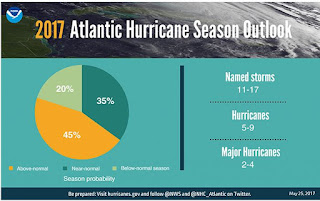#12,488
Not quite 3 weeks ago, in Hurricane Preparedness Week 2017 (May 7th - May 13th), we looked at some of the preparedness recommendations for the upcoming Atlantic Tropical Season (June 1st- Nov 30th).
At the time, early predictions (issued in April by the University of Colorado) were for a slightly lower-than-average tropical season. But times, and forecasts, change . . . and the latest calculations now suggest a more robust hurricane season.Today NOAA released their early outlook, which calls for between 11 and 17 named storms. How many of those might impact the United States, and of what severity, is unknown. But the drought of major land falling hurricanes striking the United States (the last was Wilma in October of 2005) won't last forever.
We'll touch on hurricanes, climatology, and preparedness as the summer progresses . . . but for now, we have NOAA's best guess as to what lies ahead in the following press release. A revised outlook will be issued in early August.
While these forecasts aren't always accurate, as a native Floridian, I take the threat seriously. Although some hurricanes don't measure up to the hype, the ones that do (think: Katrina, Andrew Camille, Donna . . . ), often exceed expectations.
And as they say, it only takes one hitting where you live or work, to have a major impact on your life.
Above-normal Atlantic hurricane season is most likely this year
‘Weak or non-existent’ El Nino is a factor
Weather
UPDATED: May 25, 2017. Audio from today's media call is posted to the "Resources" section below.
May 25, 2017 Forecasters at NOAA’s Climate Prediction Center say the Atlantic could see another above-normal hurricane season this year.
Last year produced 5 land-falling storms, including Matthew that caused $10 billion in damage and killed 34 people in the U.S. and 551 in the Caribbean. It was one of the deadliest Atlantic hurricanes on record.
For the upcoming Atlantic hurricane season, which runs from June 1 through November 30, forecasters predict a 45 percent chance of an above-normal season, a 35 percent chance of a near-normal season, and only a 20 percent chance of a below-normal season.
"As a Florida resident, I am particularly proud of the important work NOAA does in weather forecasting and hurricane prediction," said U.S. Secretary of Commerce Wilbur Ross. "These forecasts are important for both public safety and business planning, and are a crucial function of the federal government."
Forecasters predict a 70 percent likelihood of 11 to 17 named storms (winds of 39 mph or higher), of which 5 to 9 could become hurricanes (winds of 74 mph or higher), including 2 to 4 major hurricanes (Category 3, 4 or 5; winds of 111 mph or higher). An average season produces 12 named storms of which six become hurricanes, including three major hurricanes.
These numbers include Tropical Storm Arlene, a rare pre-season storm that formed over the eastern Atlantic in April.
“The outlook reflects our expectation of a weak or non-existent El Nino, near- or above-average sea-surface temperatures across the tropical Atlantic Ocean and Caribbean Sea, and average or weaker-than-average vertical wind shear in that same region,” said Gerry Bell, Ph.D., lead seasonal hurricane forecaster with NOAA’s Climate Prediction Center.
(Continue . . . .)
As we've discussed often, you don't have to live right on the coast to be affected by a land falling hurricane. High winds, inland flooding, and tornadoes can occur hundreds of miles inland.
While early season hurricanes are rare, they can and do occur.
So if you haven't done so already, plan a visit to NOAA's Weather-Ready Nation Hurricane Preparedness Week 2017 web page, and decide what you need to do now to keep you, your family, and your property safe during the coming tropical season.
